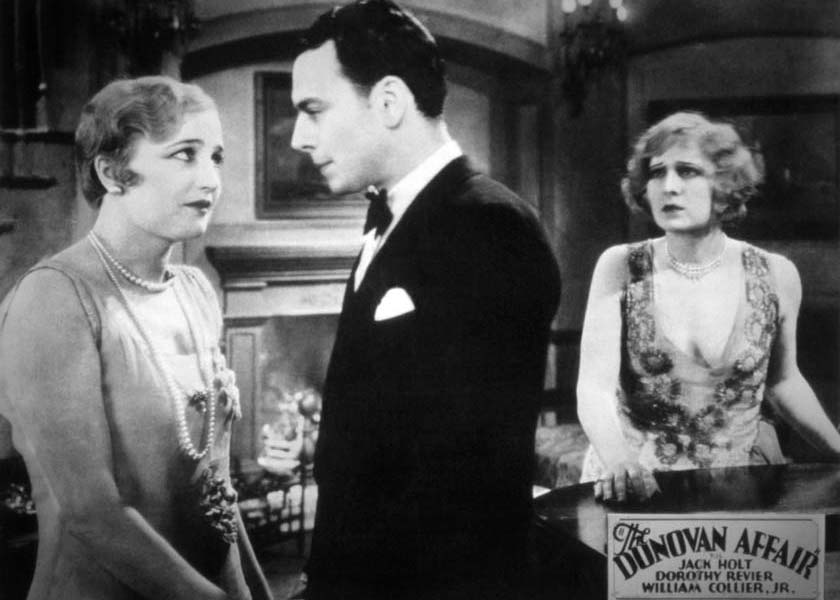Frank Capra’s first talkie, The Donovan Affair (1929), is a comic mystery based on Owen Davis' play of the same name, which was produced on Broadway in 1926. A playboy with multiple enemies attends a dinner party during which the lights are turned off (to demonstrate his glowing ring), and he is stabbed to death at the table. Enter the police: Inspector Killian (Jack Holt) and his brainless assistant Carney (Fred Kelsey). After a series of ridiculous attempts by Holt to identify the murderer, the guests gather around the table and the lights are turned off to reenact the crime. One of the diners realizes he can identify the murderer but is stabbed to death before he can speak the name. Holt makes more idiotic attempts to force the murderer into revealing himself. Finally, the guests gather around the table and once again the lights are turned off. Another of the diners suddenly claims to know who committed the murder. When the murderer tries to stab the diner, Killian nabs the culprit. It turns out to be the butler!
This mildy amusing film contains abundant clichés, such as wind, rain and lightning effects, murder in the dark, harebrained dinner guests, and re-enactments of the crime, and is replete with trite and inane elements, such as a murder victim overplayed as a cad with a magic glowing ring that makes women fall for him, slow-witted police detectives, a preposterous method of solving the murder, and a murderous butler who instantly changes from quietly friendly to violently insane.
In 1929, Frank Capra was at the beginning of ten years of excellent filmmaking. The most important talent at Columbia Pictures, Capra put himself and his studio in the first rank of the movie industry with Lady for a Day (1933), which was nominated for four Academy Awards. It Happened One Night (1934) won five Oscars, including Best Picture and Best Director, and shot Capra to the first tier of film directors, where he remained until his last film in 1961. His outstanding career makes The Donovan Affair an important film for studying Capra's development. Unfortunately, the film's entire sound track is now lost.
Unlike later processes that allowed sound to be printed directly onto film strips, early talkies, including The Donovan Affair, had their audio recorded onto discs that were shaped and played like phonograph records. Each 16-inch disc was played at 33⅓ rpm on a turntable, mechanically linked to the film projector to keep sound and picture in sync. A needle tracked from the center of the disc outward.
The only known copy of The Donovan Affair, preserved by the Library
of Congress, is visually intact, but its eight Vitaphone sound discs are missing.
Bruce Goldstein, director of repertory programming for Film Forum of New York
City, a non-profit cinema founded in 1970 that screens American and foreign
independent, art house, and classic films, has spent over twenty years
reconstructing the film's sound track. His first task was retrieving the dialogue,
however Columbia Pictures did not have a copy of the script, and the original play
proved of little assistance as the film differs significantly. Goldstein finally
found an extensive dialogue list in the archives of the New York State Board of
Film Censors,
a stenographic record (but not entirely accurate) of the dialogue, used to
ferret out any dirty bits,
which provided about 60% of the dialogue. Lip reading from the film itself
added more. Small pieces of dialogue were restored from a variety of other
sources. Goldstein believes that the current version is nearly complete, although
still a work in progress.
In 1992, Goldstein and a group of specialist voice actors presented The Donovan Affair at the Film Forum. As the voice actors spoke the lines in synchrony with the lip movements projected on screen, atmospheric and background noises were also recreated live, even including the scratching of the stylus on the sound disc. In 2013, at the Turner Classic Movie Festival, and in 2015, at the San Francisco Silent Film Festival, Goldstein again presented the film with live voice actors and sounds effects. The performers, The Gower Gulch Players, speak as closely as possible in the early 1930s manner. Although the original performances cannot be recreated exactly and the live voices are not a perfect match, the restoration makes an otherwise inaccessible film watchable.
Further Reading

